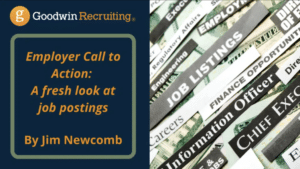Employer Call to Action: A fresh look at job postings
Jim Newcomb | Hiring Advice, Leadership, Opinion | October 18, 2022

When was the last time you took a good look at your job postings? If hiring the best people possible is vital to your company (and I hope and trust you see it that way!), they’re one of the essential tools in your toolbox. Whether candidates find them on a job board, on your site, or shared by a recruiter, the way you describe the opportunities that exist with your company can make or break your talent strategy. And yet, some companies still approach this critical piece of recruitment marketing with the same tactics that worked a decade or two ago. They don’t work today.
Employer job postings are often the first impression a candidate forms of your company. At that moment, candidates make snap decisions. Interested or not interested? Apply or don’t apply? For active candidates actively on the hunt for a new job and passive candidates, who stumble across the posting or are pointed to it by a recruiter, the posting will determine their answers to those questions. With a bit of attention to two key concepts, more of the candidates you want will say ‘yes.’
The Nuts and Bolts: Format and Structure – Employer Job Posting
Imagine you have two documents in front of you. On the left is one of your company’s job descriptions. On the right is a piece of its marketing or sales collateral. Just visually – the layout on the page – which one of these would your job posting look more like?
A job description is an internal document. It’s primarily for Human Resources, and the purpose is to capture – as comprehensively as possible – the duties and responsibilities of a job. It doesn’t have to be particularly compelling to the reader; accuracy and completeness are the primary goals. Long descriptive paragraphs? Sure. Tall lists of bullet points? Go for it. As an analogy, you could think of it as the spec sheet for a computer.
A job posting, on the other hand, is an external document. Grabbing the attention of an outside audience is the intention. This is the brochure, or the TV commercial, for that same computer to carry the analogy forward. This is the document that sells it. Now imagine reading your job post on a cell phone.
Hit Them Over The Head
If you’re trying to grab the attention of a distracted audience quickly, you need to hit them over the head (metaphorically) with only the most critical information. Long blocks of text don’t do a great job of this. Short paragraphs, made up of brief, easy-to-read sentences, do a better job. Bullet points are great if used in moderation. Save a handful of bullet points for the absolute most crucial information, the content that – if they don’t read anything else – they can’t miss.
In short, a job posting shouldn’t take any longer than a minute to read closely. If it does, you’re in ‘job description’ territory. The reader should be able to see the most important content in a quick scan of just a few seconds. Now, let’s talk about what that content should be.
Getting the Message Across: Audience and Voice
Who is the intended audience for job postings? It is the candidate. It’s funny that many job postings seem written for the company, with most of the real estate devoted to the experience and skills the company wants the candidate to have.
Today’s candidate asks a different question: What’s in it for me?
I am not suggesting that a job posting shouldn’t include a few notes about essential skills or experience that you want a candidate to have. The lion’s share of the content should answer the question ‘Why should I work here?‘. If it mostly answers the questions, ‘What do I need to have to apply?‘ and ‘What tasks will I perform?‘, it’s a job description.
Employer Job Postings Should Describe the Employee Experience
A marvelous job posting paints a picture for the candidate about the employee experience they would have working for your company, in the role you’re hiring for, allowing them to see themselves in the role. One way to do this is to speak directly to the kind of candidate you ideally want in the role, starting sentences with phrases like, “You are …”, “You see …”, and “You enjoy …”.
Employer Job Postings Should Be Authentic
Finally, let’s talk about voice. Don’t be afraid to let your company’s personality show through but be authentic. Don’t use language that you think will appeal to a specific audience – use very casual language and slang to speak to younger candidates. Not every company is laid back and informal, and that’s okay. Use the same phrasing and tone you’d find in your sales and marketing material. It will speak to the candidates that will fit well in your organization.
A fresh take on job postings can ensure that more of the candidates you want to hire see themselves in those postings, see themselves in the job, and respond to your call to action.
Need Help?
If this seems daunting to you, or you simply need to augment your efforts by letting us throw a wider net for you, we’re here to help.
Employer Job Postings Additional Resources
Recruiting.com: How to Write Effective Job Postings
Insperity.com: How to write a great job posting: 7 smart tips
Indeed.com: Writing a Job Posting
LinkedIn.com: 7 Tips for Writing Job Posts that Attract Candidates
LinkedIn.com: 3 Steps for Writing More Compelling Job Ads that Will’ Hook” Candidates Quickly
Share This Article














































